Picture this: you’ve been hitting the gym hard, pushing through heavy weights like a champ, and chasing body strength gains like they owe you money …
Then, one day, your muscles start to feel more like overcooked spaghetti. You’re sore and tired, and your progress stalls.
That’s your body waving a giant “you need a deload week” flag. But what is a deload week?
What is a Deload Week?
A deload week is a training period with decreased intensity, volume, or both. It’s designed to help your body recover while still staying active.
Think of it as a maintenance week for your nervous system, joints, and muscles.
You don’t stop training altogether—you simply back off a bit to promote recovery and reduce stress.
Benefits of a Deload Week

Research suggests that scheduling regular deload weeks helps avoid:
- Overtraining
- Reduce mental fatigue
- Decrease injury risk
It’s a smart way to keep your athletic performance and fitness gains on track without overdoing it.
For instance, a study shows that adequate recuperation is needed with intense workouts to reduce sclerostin production, which is responsible for weaker bones.
Deloading gives your joints a chance to recover and allows for better bone formation.
Signs You Need a Deload Week
If you need a deload week, here’s a quick checklist:
- Your workouts feel harder than usual, even at the same intensity or weight.
- You’re constantly tired, both physically and mentally.
- You’ve hit a training plateau and aren’t seeing progress.
- Your energy levels are lower.
- You’re dealing with nagging aches or potential injury.
If any of these sound familiar, it’s time to give your body a break with a deload week.
How Often Should You Take a Deload Week?
For most training plans, a deload week is ideal every 4–8 weeks. Depending on your training volume and intensity.
Competitive athletes or those engaging in high-intensity workouts need to deload more frequently. While recreational athletes can space them out a bit more.
The key is to listen to your body. If you’re grinding through heavy weights week after week, don’t wait for your nervous system to scream at you.
Plan ahead and make regular deload weeks part of your training schedule.
What to Do During a Deload Week / How to Deload Properly
So, you’ve decided to take a deload week—good call! Here’s what to do:
- Reduce Volume: Cut your training volume by 30–50%. For example, if you usually do 6 sets, try 3 or 4.
- Lower Intensity: Use lighter weights, reducing your usual load by 50–70%.
- Active Recovery: Incorporate activities such as low-intensity swimming or walking to keep moving without taxing your nervous system.
- Fewer Days: Train on fewer days during the week to allow for more rest.
Remember, the goal is not to sit on the couch eating pizza (although a slice or two won’t hurt)—it’s to recover without losing momentum.
What to Do After a Deload Week

After your deload week, it’s time to return to your training plan with renewed energy. Use this as an opportunity to reassess your workout routine and make adjustments based on your pre-deload starting point.
More reps, higher volume, and even a slight increase in exertion are all fair game.
What Happens if You Don’t Deload?
Skipping a deload period can lead to a cascade of problems:
- Increased fatigue and mental stress.
- Higher risk of injury due to overworked muscles and joints.
- Prolonged training plateaus that leave you spinning your wheels.
Worst of all? Neglecting to deload can actually harm your fitness gains.
Will I Lose Muscle if I Deload?

Research shows that you won’t lose your hard-earned muscle mass by taking a deload week. In fact, reducing training intensity can help your body recover, paving the way for muscle hypertrophy and strength training gains. Trust the process.
Is It Better to Deload or Take a Break?
A deload week is better than a complete break, especially if you’re trying to maintain momentum.
While a break may help with extreme burnout, deloading keeps your nervous system engaged and your muscles active. Plus, who wants to feel like a newbie when they return to the gym?
Should Beginners Do Deload Weeks?

Beginners might think they don’t need a deload, and in general, they probably don’t need a deload week as much or as often as someone who has been lifting weights for many years.
This is because a new gym goer will not train as hard as an experienced lifter.
However, newer gym goers should be mindful of having a deload week now and then after they’ve trained consistently for a while.
It is always wise to break up your training so your body doesn’t suffer from burnout.
Deload Week Summary
So, if you’re pushing hard in the gym and your body starts throwing up red flags, don’t hesitate to take a deload week. It’s not about slacking off—it’s about being smart and giving your body the proper recovery it needs to crush your goals.
F&Q
Is one week of deload enough?
Yes, one week is generally enough for most people to reap the benefits of a deload. It allows your body to recover, reduce accumulated fatigue, and restore strength without losing progress.
However, the duration will vary depending on training intensity, volume, and individual recovery needs. Some athletes may require a slightly longer or shorter period, depending on personal performance levels.
What if I never deload?
Skipping a deload can lead to overtraining, increased risk of injury, and performance plateaus. Without a proper recovery phase, your body doesn’t get the opportunity to repair and strengthen itself, which can hinder long-term progression.
Regularly incorporating a planned deload week ensures you maintain sustainable training and avoid burnout.
Is deloading every 4 weeks too much?
For most people, deloading every 4 weeks might only be necessary if your training program is highly intense in volume and load.
The frequency of a deload should depend on your training plan, goals, and how well your body recovers. Many people adapt well to a deload every 4–6 weeks.
Does a deload week build muscle?
While a deload week is not directly focused on muscle building, it indirectly supports muscle growth.
Deloading gives your muscles, tissues, and nervous system time to recuperate and adapt, ensuring you return to training stronger and more capable of making progress.
It’s a key part of long-term muscle development and overall performance.
If you’d like to learn more about structuring your training program or need personalized advice, contact me!


